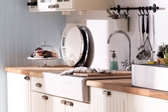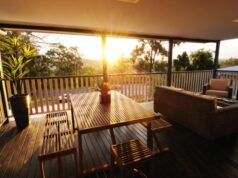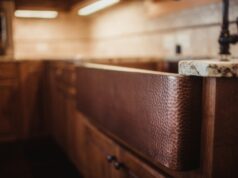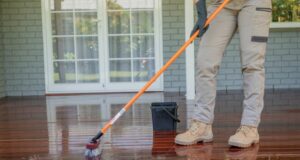
Timber has a uniquely ‘warm’ feel to it, is light, and can be shaped to suit any taste. Timber bench tops are prone to scratching, but they can also be sanded back and resealed fairly easily.

If you want something a little ‘warmer’ and more natural in your kitchen, you may like to consider a timber benchtop. Timber can be made to suit just about any style of kitchen, and is a very elegant complement to many other materials – it goes particularly well with modern stainless steel appliances.
How are timber benchtops made?
Timber benchtops can be manufactured using seasoned, pre-treated timber either as single solid slabs (which can look quite dramatic), as glue-bonded pieces (referred to as ‘glued laminated timber’, or simply ‘glulam’), or as veneered sections to the top of other materials (like particleboard or MDF). There are a variety of different ways to prepare timber for use as a benchtop surface. Timber benchtops are normally sealed using either polyurethane or a suitable oil – which will need to be reapplied to keep protecting the timber.
There are countless different species of timber that can be used for benchtops too, each with varying aesthetic qualities relating to grain and colour. With a few exceptions, locally sourced timber is normally considerably cheaper and more environmentally friendly than imported varieties, and in many cases people will opt to use a species local to the area.
Common choices in Australia include things like Red Gum, Tasmanian Oak, Black Butt, Jarrah, Victorian Ash, Spotted Gum and Blue Gum, to name a few. Although it’s not technically a timber, bamboo can also be used in much the same way – and may be a very environmentally conscious choice if it’s properly sourced and constructed.
What are the properties of timber kitchen benchtops?
One of the nicest things about timber is that if you mark the material in any way, it can easily be sanded back and repolished. It should be noted that timber does scratch, stain and burn easily, so it needs to be maintained properly and constantly.
Like any wood product, timber does age, but with timber this is more of a strength than a weakness. Ageing and wear will give timber benchtops a very attractive patina, and add to the look and character of the wood.
Regular treatment with either polyurethane or wood oil is essential to protect the wood and prevent it from drying out. Polyurethane creates a high gloss finish, is durable and requires less maintenance than an oiled timber benchtop. If you decide to oil the timber to achieve a matte timber finish, it will need regular recoating, however it will be easier to repair.
|
Advantages
|
Disadvantages
|





